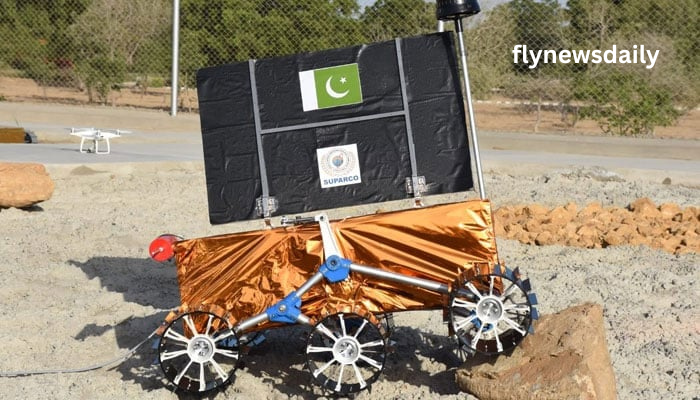
In a monumental leap for space exploration and scientific collaboration, Pakistan and China have embarked on a historic partnership for the ambitious Moon Mission-II. This mission symbolizes a significant milestone, marking Pakistan’s first major collaboration in lunar exploration and showcasing China’s expanding influence in the global space community. By venturing into the lunar landscape together, Pakistan and China are set to break new ground and set the stage for an era of discovery, shared scientific insight, and technological advancement.
The Vision Behind Moon Mission-II
The decision to collaborate on the ambitious Moon Mission-II stems from Pakistan and China’s shared goal of advancing space research and science. This partnership provides Pakistan with previously unheard-of chances to expand its knowledge of satellite technology, space science, and aerospace engineering, opening the door for future autonomous missions. This partnership demonstrates China’s dedication to promoting collaboration with its neighbours and further establishes its position as a leader in space exploration worldwide.
Exploring unexplored areas of the Moon’s surface is the main goal of Moon Mission-II. The South Pole-Aitken Basin is a region of great scientific interest because of its composition of lunar ice and other valuable minerals. Both the long-term objective of exploring Mars and lunar studies will benefit from the mission’s critical findings.
Technological Innovations and Objectives of Moon Mission-II
Moon Mission-II represents one of the most technologically advanced lunar expeditions to date, with a variety of objectives that include exploring the lunar surface, analyzing geological samples, and mapping resources. Key innovations in the mission include:
- Advanced Rover Technology: Equipped with cutting-edge sensors and a specially designed mobility system, the lunar rover will traverse challenging terrain, collecting data on the Moon’s geological structure and chemical composition.
- Resource Mapping: One primary mission goal is to identify and analyze lunar resources, including water ice, which is believed to be abundant in permanently shadowed craters. These resources are not only scientifically valuable but could also prove essential for future human space exploration.
- Radiation Studies: The mission will measure and analyze radiation levels on the lunar surface, providing crucial data for assessing the risks associated with long-term human presence on the Moon.
- AI-Driven Lunar Exploration: Moon Mission-II employs advanced AI algorithms to enhance navigation, decision-making, and data analysis. This AI-driven approach will enable the rover to independently navigate the lunar surface, ensuring that valuable scientific insights are gathered efficiently.
A New Era of Sino-Pakistani Space Cooperation
Moon Mission-II is an important step for Pakistan in becoming a space research presence. Pakistan is receiving practical experience and substantial information transfer in the field of space research through its collaboration with China. Through this partnership, the Pakistan Space and Upper Atmosphere Research Commission (SUPARCO) would be better equipped to plan and carry out space missions on its own in the future.
The project demonstrates a growing strategic partnership between the two countries and represents more than just technological cooperation. China offers Pakistan resources and experience that it can use to improve its own capabilities because of its strong space program and track record of lunar exploration through the Chang’e missions. Given the growing significance of cooperation in space exploration on a global basis, this relationship may encourage further regional cooperation in science and space.
Challenges and Solutions for Moon Mission-II
As with any complex space mission, Moon Mission-II faces several challenges that require sophisticated solutions:
- Communication with Earth: Establishing a consistent and reliable communication link between the lunar rover and mission control on Earth is crucial. Advanced satellite technology, including relay satellites in lunar orbit, will play a key role in maintaining connectivity.
- Lunar Terrain and Mobility: The Moon’s rough and unpredictable surface presents mobility challenges for the rover. Innovative wheel designs and suspension systems are integrated into the rover, allowing it to maneuver over rocks, craters, and slopes.
- Harsh Lunar Environment: With extreme temperatures, high radiation, and lack of atmosphere, the Moon’s environment is unforgiving. Special insulation and radiation shielding have been added to protect the mission’s equipment and ensure functionality throughout the mission duration.
- Data Storage and Transmission: Given the high volume of data expected from geological surveys and other measurements, data storage and real-time transmission are crucial. Advanced data compression technologies and relay stations are utilized to ensure that critical data is transmitted back to Earth with minimal delay.
Scientific Significance of Moon Mission-II
The potential scientific breakthroughs of Moon Mission-II are profound. By exploring new regions of the Moon, this mission is set to contribute to our understanding of the Moon’s geological evolution, the presence of lunar ice, and the potential resources that could support sustained human presence in space. Key scientific objectives include:
- Lunar Soil Analysis: Examining the mineral and chemical composition of lunar soil will provide insights into the Moon’s formation and history. This data may even offer clues about the early solar system.
- Impact of Lunar Radiation on Electronics: With equipment specifically designed to withstand the Moon’s radiation, the mission will provide new data on how space environments impact electronic components. This research is essential for planning future human missions to the Moon and Mars.
- Water Ice Mapping: By analyzing lunar ice deposits, Moon Mission-II aims to determine the quantity and accessibility of water on the Moon, which is crucial for any plans to establish a long-term human presence there.
The Future of Space Exploration in South Asia
The growing desire of South Asian countries to take part in space exploration is reflected in Pakistan’s participation in Moon Mission-II. By making strides in scientific research and space technology, Pakistan is opening the door for other countries in the region to see the value of space programs. This mission may encourage collaborations among neighbouring nations, promoting scientific cooperation and regional stability.
In addition to confirming Pakistan’s developing space science skills, the accomplishment of Moon Mission-II will put the country among those actively engaged in lunar exploration. This accomplishment may pave the way for future partnerships with other space organisations, raising South Asia’s profile in the space exploration community and creating opportunities for international cooperation.
How Moon Mission-II Can Pave the Way for Mars Exploration
For China’s and Pakistan’s larger space exploration goals, such as prospective expeditions to Mars, the expertise acquired from Moon Mission-II will be an essential first step. Both countries can better prepare for the technological challenges that lie ahead on Mars by testing scientific instruments, systems, and technologies on the Moon.
For instance, it will be crucial to research how the lunar climate affects technology in order to create equipment that can survive the more severe circumstances on Mars. Additionally, the information on mineral deposits and water ice will provide information that may help direct future resource-gathering expeditions to other planets. Moon Mission-II is ultimately a crucial step in realising humanity’s long-term objective of becoming a multiplanetary species.
Conclusion: A Bold Step Toward the Stars
The partnership between China and Pakistan on Moon Mission-II represents a turning point in the country’s scientific and technical development. Pakistan is paving the way for a future in which space research is essential to South Asia’s technological development as it embarks on its initial lunar exploration. More than just a search for information, this purpose stands for an inspiring dedication to creativity, teamwork, and the limitless potential of the universe.
By working together, China and Pakistan are demonstrating that space exploration is not limited to a select group of powerful countries.
but an opportunity for shared human achievement. As Moon Mission-II unfolds, it will offer insights and breakthroughs that inspire scientists, engineers, and space enthusiasts worldwide.



